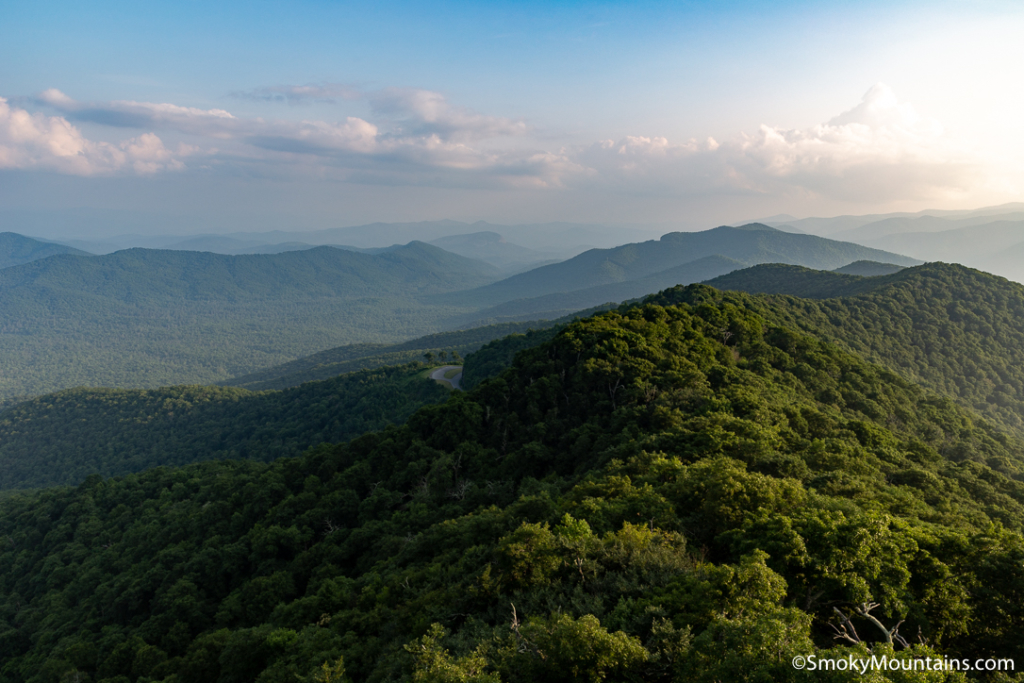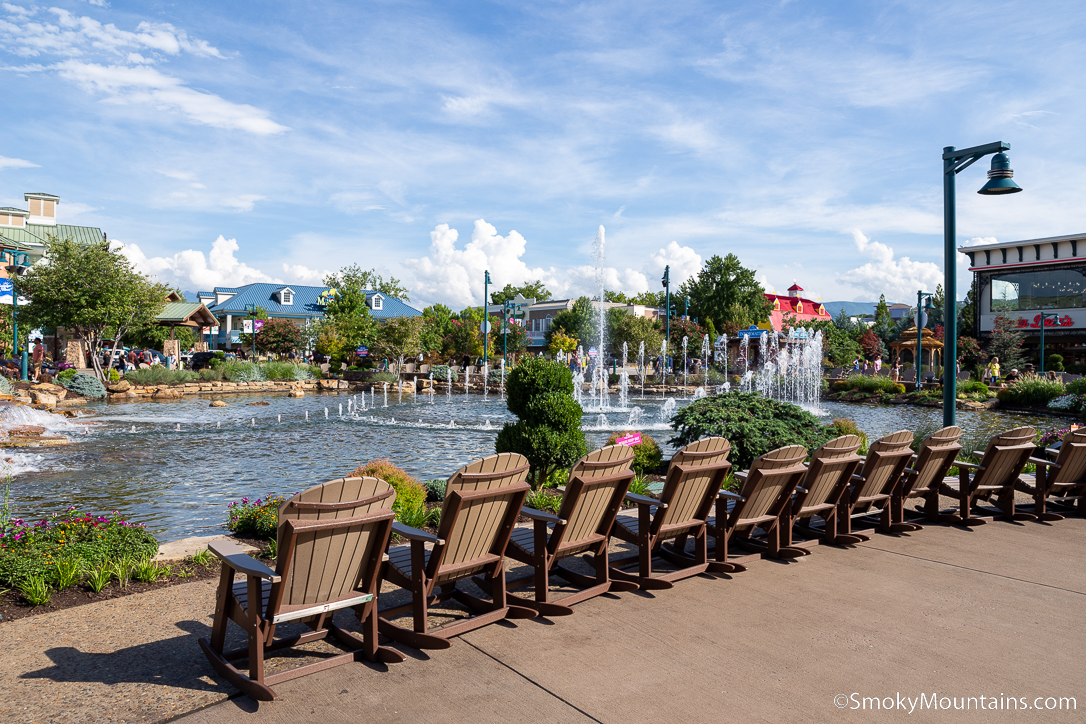The United States can proudly lay claim to being the birthplace of the national-park concept. (“America’s Best Idea,” as it’s often called.) The first, Yellowstone, was established back in 1872. Since then, dozens and dozens more have been created, preserving and showcasing some of the most remarkable scenery and ecosystems on the continent.
It’s not easy to carve down a list of the 25 top national parks in the country. In our list below, needless to say, we’re leaving off some mighty fine National Park System units. We’ve chosen the following—presented in no particular order—for certain superlative attributes, including visitation rates, size, and natural resources. But think of this lineup as a starter pack, with plenty of other fine parks to explore: including some deliciously under-the-radar ones!
Great Smoky Mountains National Park (Tennessee/North Carolina)

Consistently the most-visited national park in the country—it saw 14.1 million recreational visits in 2021—Great Smoky Mountains presents the Southern Appalachians at their finest. Containing some of the highest peaks in the East, this 522,427-acre park also includes large tracts of old-growth in among the world’s most diverse temperate forests. While roads access some of the standout landmarks—Cades Cove, Clingmans Dome, Cataloochee Valley.—large portions of the Great Smokies are wild backcountry.
Wrangell-St. Elias National Park & Preserve (Alaska)

Photo Credit by @alaskanps on Instagram
By a fair measure, Wrangell-St. Elias is the country’s largest national park. The park and preserve encompass 13.18 million acres, more than eight million of which form the national park proper. That acreage also includes the single biggest federal wilderness area in the U.S. The landscape is monumental, including the ice-clad peaks of the Wrangell and Saint Elias mountains. The latter, the loftiest coastal mountains on Earth, include 18,008-foot Mount Saint Elias on the Alaska-Yukon border: the second-highest peak in both the U.S. and Canada. Grizzlies, wolves, mountain goats, caribou, wolverines, and moose are among the rich roster of mammals.
Yellowstone National Park (Wyoming/Montana/Idaho)

Photo Credit by @yellowstonenps on Instagram
This oldest national park in the world is also one of the Lower 48’s largest, and linchpin of the globally outstanding Greater Yellowstone Ecosystem in the Middle Rockies. Yellowstone abounds with superlatives: the greatest collection of geysers on Earth, one of the biggest canyons in the Rockies (the Grand Canyon of the Yellowstone), and some of North America’s highest concentrations of big mammals. And the foundation of the landscape is the Yellowstone Supervolcano, prehistorically responsible for some of the largest eruptions anywhere.
Grand Canyon National Park (Arizona)

Photo Credit by @brittanyowensmicek on Instagram
A magnificent portion of the Grand Canyon of the Colorado River—close to 300 miles long, 18 miles wide, and 6,000 or so feet deep—lies within this hugely popular park. While not the deepest or largest canyon in the world, you could argue the Grand is the single most stunning. Rocks approaching two billion years old outcrop within its gaping, colorful maw, unforgettably perceived from both the North and South rims.
Yosemite National Park (California)

Photo Credit by @brygoesonadventures on Instagram
Few places are so singularly beautiful as Yosemite Valley in the northern Sierra Nevada. That granite-walled, waterfall-lined glen is the centerpiece of Yosemite National Park, which also includes extensive backcountry in the High Sierra. From the loom of El Capitan and Half Dome to magisterial sequoia groves, Yosemite—celebrated early on by John Muir—is sheer magic. (Just make sure to keep your food properly secured from those infamously clever Yosemite black bears!)
Acadia National Park (Maine)

Photo Credit by @imagesofacadia on Instagram
Acadia covers almost 50,000 acres of the Downeast Maine coast, including much of Mount Desert Island. That island rises to 1,530-foot Cadillac Mountain, the loftiest height along the immediate coast of the Eastern Seaboard. Acadia’s pleasures are many, from catching the sunrise from Cadillac and kayaking offshore islets to basking in sumptuous fall colors.
Rocky Mountain National Park (Colorado)

Photo Credit by @arthurmessal on Instagram
The Front Range of the Southern Rockies, capped here by one of the famous “fourteener” Longs Peak, is on full, glorious display in Rocky Mountain National Park. From shimmering aspen forests to vast, rolling alpine tundra, the landscapes are magnificent here. Bugling elk in fall are the icing on the cake. You can also pay your respects to the headwaters of mighty Colorado, which rises in the park’s Never Summer Mountains.
Hawaii Volcanoes National Park (Hawaii)

Photo Credit by @nikhil_fotography on Instagram
The 323,000-odd acres of this Big Island national park include the biggest subaerial volcano on Earth—Mauna Loa, rising some 55,000 feet above its base far below sea level—and perhaps the most active, Kilauea. From lava lakes and fountains to rainforest tree ferns and Native Hawaiian petroglyphs, Hawaii Volcanoes is another absolute crown jewel of the National Park System.
Zion National Park (Utah)

Photo Credit by @photographsbykuol on Instagram
Zion’s giant cliffs and domes represent one of the scenic high points of the (ridiculously scenic) Colorado Plateau. Here along the White Cliffs of the Grand Staircase, the North Fork Virgin River’s gorge dazzles with every sightline—not least from the famous vantage of Angels Rest. The less-visited Kolob Canyons portion of the park includes one of the world’s biggest rock arches, the Kolob Arch. Like Grand Canyon, Zion is one of the few corners of the U.S. where you can spot California condors.
Everglades National Park (Florida)

Photo Credit by @hiker_babes_southernflorida on Instagram
There’s no place in the country like the “River of Grass.” Indeed, there’s no place in the world quite like it. Everglades National Park protects the singular sheet-flow marshland of the Everglades proper, with its sawgrass flats and tropical hardwood hammocks. It also encompasses pineland blocks and one of the Western Hemisphere’s biggest mangrove swamps. The tropical climate nourishes magnificent royal palms, strangler figs, and West Indian mahoganies. And the faunal cast of characters is utterly unique, with manatees, American crocodiles, American alligators, Florida panthers, black bears, wood storks, swallow-tailed kites, and more all rubbing shoulders.
Shenandoah National Park (Virginia)

Photo Credit by @karaleighcreative on Instagram
Postcard Appalachian beauty awaits within ready reach of many of the East Coast’s major cities at Shenandoah. Here, the Blue Ridge Mountains—including 3,474-foot Hawksbill Mountain and 3,284-foot Old Rag Mountain—rear high above the pastoral Shenandoah Valley. Long views are everywhere, whitetails and black bears abundant. Skyline Drive cutting through the park links southward with the Blue Ridge Parkway, “America’s Favorite Drive,” running all the way down to the Smokies.
Glacier National Park (Montana)

Photo Credit by @dillon.britt.39 on Instagram
Million-acre Glacier crystallizes the scenic glories and wildness of the Crown of the Continent Ecosystem in the Northern Rockies. This wonderland merges with Alberta’s Waterton Lakes National Park as the Waterton-Glacier International Peace Park (and Dark Sky Reserve). Spectacular mountains—with a dwindling supply of alpine glaciers—sweep skyward, backdropping mountain goats, elk, grizzly bears, wolves, bighorns, and other heraldic critters.
Sequoia & Kings Canyon National Parks (California)

Photo Credit by @riverdoofus on Instagram
Big mountains, big gorges, big trees: Kings Canyon and Sequoia national parks embody the splendor of the Sierra Nevada. These adjoining parks include the high peaks of the Muir Crest—including 14,505-foot Mount Whitney, the Lower 48’s king peak—and the Great Western Divide. Some of the deepest gorges in North America, Kings and Kern canyons, lie here. So do numerous groves of the world’s most massive tree, the giant sequoia, including the Giant Forest, host to the biggest sequoia of all: the 52,508-cubic-foot General Sherman Tree.
Congaree National Park (South Carolina)

Photo Credit by @andytmartin10 on Instagram
A relatively new national park, Congaree protects one of America’s largest old-growth bottomland forests. This floodplain forest along the Congaree River also boasts one of the tallest canopies of any temperate forest on Earth, with soaring loblolly pines, cherry bark oaks, bald-cypresses, and other swamp-happy trees.
Olympic National Park (Washington)

Photo Credit by @elliothawkey on Instagram
Comprising the heart of the Olympic Peninsula and parts of its western coastline, Olympic National Park encapsulates the Pacific Northwest’s glory. Most of its 923,000 acres are a rugged, roadless wilderness, sweeping from heavily forested valleys and basins to the glaciated massifs and horns of the Olympic Mountains. West-draining valleys include defining examples of Pacific Northwest temperate rainforest, and the Pacific coast is one of America’s wildest oceanfronts. Hikers in this backpacker’s paradise often spot Roosevelt elk, the biggest elk subspecies and monarchs of the Peninsula.
Voyageurs National Park (Minnesota)

Photo Credit by @mike.treloar.photog on Instagram
Experience the Northwoods at their wildest in Voyageurs National Park, host to Canadian Shield Rocklands, northern hardwood/boreal forest, and loads of loon-cruised lakes. The bulk of the park is the roadless Kabetogama Peninsula, and outside wintertime campsites are accessible only by boat. It’s not uncommon to hear the howls of gray (“timber”) wolves while paddling or hiking.
Death Valley National Park (California)

Photo Credit by @landscapephotosmith on Instagram
At some 3.4 million acres, Death Valley ranks as the largest national park in the conterminous U.S. It’s also one of the most extreme places in North America, hosting the continent’s lowest point (Badwater Basin, 282 feet below sea level) and experiencing its harshest summertime temperatures. The landscapes here at the northwestern edge of the Mojave Desert are ethereal: from saltpans, badlands, and dunes to the craggy heights of the Panamints. The latter attain 11,049 feet on Telescope Peak, a mere 15 or so miles from Badwater Basin’s remarkable sink.
Denali National Park & Preserve (Alaska)

Photo Credit by @adventuresofzo on Instagram
Tundra valleys framed by the huge white ramparts of the Alaska Range make for breathtaking vistas in Denali. Those ramparts rise to North America’s high point: 20,343-foot Denali, an utterly monumental mountain, though other mighty peaks form the skyline, including 17,400-foot Mount Foraker and the remote Kichatna pillars. The open, wild countryside makes for top-notch safari-going, with Dall sheep, wolves, caribou, grizzlies, moose, and lynx among the stars of the show.
Grand Teton National Park (Wyoming)

Photo Credit by @ms.madison on Instagram
Connected to nearby Yellowstone by the John D. Rockefeller, Jr. Memorial Parkway, Grand Teton presents among North America’s quintessential mountainscapes. The high prongs of the Teton Range, culminating in 13,775-foot Grand Teton itself, make a swoony battlement above the Snake River flats of Jackson Hole. Marvel at grazing bison, mousing coyotes, and wading moose, and seek out remote alpine lakes and glacial ice in the high country.
Badlands National Park (South Dakota)

Photo Credit by @verenaknemeyer on Instagram
Beautifully barren pinnacles, spurs, and amphitheaters form the White River Badlands of South Dakota, a signature swath of the Great Plains. The eroded natural ruins of the Wall escarpment are the main attraction, but Badlands National Park also protects the biggest pristine extent of mixed-grass prairie in the country. Highly watchable wildlife ranges from prairie dogs, burrowing owls, and black-footed ferrets to fleet pronghorn and hulking bison. And this is a deeply sacred, history-drenched landscape to the Oglala Lakota, who co-manage the park’s remote South Unit with the Park Service.
Redwood National & State Parks (California)

Photo Credit by @eugenedyachkin on Instagram
Redwood National Park links to a collection of outstanding state parks—Jedediah Smith, Prairie Creek Redwoods, and Del Norte Coast Redwoods—to form a 139,000-acre temperate-rainforest jewel. This culmination of Northern California’s redwood coast includes Earth’s tallest trees, with the most skyscraping redwoods of all within the national park’s remote, fern-tangled backcountry.
Crater Lake National Park (Oregon)

Photo Credit by @lesliematax on Instagram
Among the planet’s clearest and deepest lakes occupy the blasted caldera of Mount Mazama in the Southern Cascades of Oregon. Crater Lake must be seen to be believed; pictures just can’t capture its mesmerizing effect. The waters come broken by Wizard Island and the pinnacled Phantom Ship, while the rim includes bold crags and hoodooed slopes. Extensive backcountry subalpine forest blankets the surrounding highlands, broken by the Pumice Desert.
Great Sand Dunes National Park & Preserve (Colorado)

Photo Credit by @_sherlock_the_goldenretriever_ on Instagram
North America’s tallest sand dunes—cresting past 700 feet—nestle against the Sangre de Cristo Mountains of the Southern Rockies in this gorgeous parkland. Indeed, this dune field on the edge of the San Luis Valley includes some of the tallest inland sand formations on Earth. The national park proper centers on the dunes, while the national preserve portion rises past 13,000 feet up among the Sangre de Cristo peaks.
Mount Rainier National Park (Washington)

Photo Credit by @michaelbollino on Instagram
The absolutely commanding, iced-over bulk of 14,411-foot Mount Rainier, the tallest of the Cascade Range stratovolcanoes, utterly dominates this venerable national park, established in 1899. The glaciers and icefalls of “Tahoma” (a prevailing indigenous name for the mountain) draw the eye, but the park includes many other attractions, including superb temperate rainforest and multiple waterfalls.
Arches National Park (Utah)

Photo Credit by @wyatt.mulleen on Instagram
The Entrada Sandstone of the Colorado Plateau comes worn and whittled into better than 2,000 rock arches and other surreal formations in this park on the doorstep of Moab, Utah. Iconic landforms include Delicate Arch, Balanced Rock, and, in the Devils Garden, Landscape Arch, which ranks among the longest arches on Earth.




